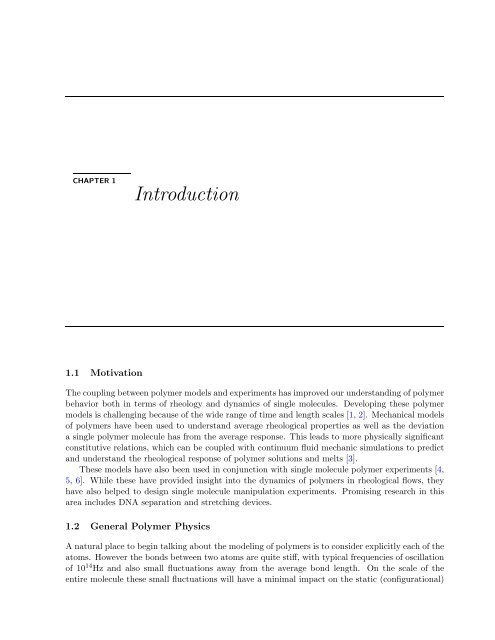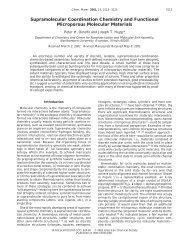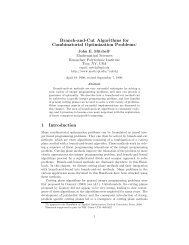Systematic development of coarse-grained polymer models Patrick ...
Systematic development of coarse-grained polymer models Patrick ...
Systematic development of coarse-grained polymer models Patrick ...
Create successful ePaper yourself
Turn your PDF publications into a flip-book with our unique Google optimized e-Paper software.
CHAPTER 1<br />
1.1 Motivation<br />
Introduction<br />
The coupling between <strong>polymer</strong> <strong>models</strong> and experiments has improved our understanding <strong>of</strong> <strong>polymer</strong><br />
behavior both in terms <strong>of</strong> rheology and dynamics <strong>of</strong> single molecules. Developing these <strong>polymer</strong><br />
<strong>models</strong> is challenging because <strong>of</strong> the wide range <strong>of</strong> time and length scales [1, 2]. Mechanical <strong>models</strong><br />
<strong>of</strong> <strong>polymer</strong>s have been used to understand average rheological properties as well as the deviation<br />
a single <strong>polymer</strong> molecule has from the average response. This leads to more physically significant<br />
constitutive relations, which can be coupled with continuum fluid mechanic simulations to predict<br />
and understand the rheological response <strong>of</strong> <strong>polymer</strong> solutions and melts [3].<br />
These <strong>models</strong> have also been used in conjunction with single molecule <strong>polymer</strong> experiments [4,<br />
5, 6]. While these have provided insight into the dynamics <strong>of</strong> <strong>polymer</strong>s in rheological flows, they<br />
have also helped to design single molecule manipulation experiments. Promising research in this<br />
area includes DNA separation and stretching devices.<br />
1.2 General Polymer Physics<br />
A natural place to begin talking about the modeling <strong>of</strong> <strong>polymer</strong>s is to consider explicitly each <strong>of</strong> the<br />
atoms. However the bonds between two atoms are quite stiff, with typical frequencies <strong>of</strong> oscillation<br />
<strong>of</strong> 10 14 Hz and also small fluctuations away from the average bond length. On the scale <strong>of</strong> the<br />
entire molecule these small fluctuations will have a minimal impact on the static (configurational)







